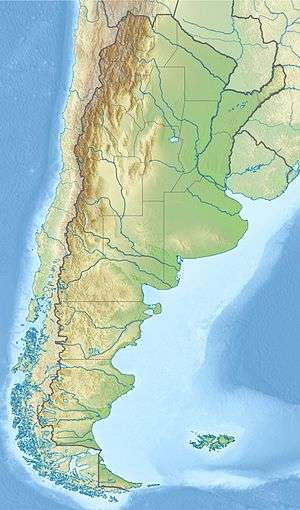Laguna Amarga
| Laguna Amarga | |
|---|---|
 Laguna Amarga | |
| Highest point | |
| Coordinates | 27°32′33″S 68°21′51″W / 27.54250°S 68.36417°WCoordinates: 27°32′33″S 68°21′51″W / 27.54250°S 68.36417°W GEOnet Names Server |
| Geography | |
| Location | Catamarca Province, Argentina |
| Geology | |
| Age of rock | Pliocene-Pleistocene |
| Mountain type | Caldera |
| Volcanic arc/belt | Central Volcanic Zone |
| Last eruption | 3.0 ± 0.2 mya |
Laguna Amarga is a caldera and associated ignimbrite in the Andes of northwestern Argentina.
Laguna Amarga is part of the southern Central Volcanic Zone and one among several Miocene-Pliocene-Pleistocene volcanic centres of this volcanic region. The formation of magma chambers and thus of large volcanic systems has apparently been influenced by tectonic changes. The Laguna Amarga caldera is associated with the Cordillera Claudio Gay faults together with the Laguna Escondida and Wheelwright calderas, all of which are between 6.5 and 4 mya old.[1] Laguna Amarga and Laguna Verde are sometimes associated with the Vallecito ignimbrite instead.[2] The formation of the Laguna Amarga volcanic centre was probably influenced by orogenic changes in the Andes which triggered the formation of fractures in the crust.[3]
The Laguna Amarga caldera has a diametre of 33 kilometres (21 mi) and is linked to the Laguna Escondida caldera.[1]
The 630 km3 (150 cu mi) Laguna Verde ignimbrite was erupted 4-3 mya ago and is associated with these two calderas.[1] Other dates are 4.5 ± 0.5 to 3.0 ± 0.2 mya. The ignimbrite covers an area of 86.46 km2 (33.38 sq mi), cropping out southwest of the Laguna Amarga ignimbrite.[4] The Laguna Verde ignimbrite ranges from dacite to rhyolite in composition, containing biotite, pumice, quartz and sanidine.[2]
The Laguna Amarga ignimbrite was erupted 5.1 mya ago,[5] or 3.7-4.1 mya, and it has a volume of over 70 km3 (17 cu mi).[6] It extends north-northwest from Peinado volcano. The ignimbrite is somewhat welded and contains vesicular pumice, and bears some similarity with the Cyclops ignimbrite 50 km (31 mi) away.[7] Further, the Laguna Amarga ignimbrites like the Cerro Blanco and Galan ignimbrites are rich in sodium.[6] It covers a surface area of 611.02 km2 (235.92 sq mi), cropping out around the Laguna Amarga. Another ignimbrite, Los Colorados, is located at the edge of the Amarga caldera but its eruptive centre is unknown.[4]
References
- 1 2 3 Naranjo, José Antonio; Villa, Víctor; Ramírez, Cristián; Pérez de Arce, Carlos. "Oligo - Holocene evolution of the southern part of the Central Andes: volcanism and tectonic" (PDF). biblioserver.sernageomin.cl. SERNAGEOMIN. Retrieved 21 June 2016.
- 1 2 Kay, Suzanne Mahlburg; Coira, Beatriz; Mpodozis, Constantino (2008). "Field trip guide: Neogene evolution of the central Andean Puna plateau and southern Central Volcanic Zone". 13: 117–181. doi:10.1130/2008.0013(05).
- ↑ Seggiaro, R.E.; Hongn, F.D. (1999). "Influencia tectónica en el volcanismo Cenozoico del Noroeste argentino". Acta geológica hispánica. 34 (2-3): 228–242. Retrieved 21 June 2016.
- 1 2 Guzmán, Silvina; Grosse, Pablo; Montero-López, Carolina; Hongn, Fernando; Pilger, Rex; Petrinovic, Ivan; Seggiaro, Raúl; Aramayo, Alejandro (December 2014). "Spatial–temporal distribution of explosive volcanism in the 25–28°S segment of the Andean Central Volcanic Zone". Tectonophysics. 636: 170–189. doi:10.1016/j.tecto.2014.08.013.
- ↑ Schnurr, W.B.W.; Trumbull, R.B.; Clavero, J.; Hahne, K.; Siebel, W.; Gardeweg, M. (September 2007). "Twenty-five million years of silicic volcanism in the southern central volcanic zone of the Andes: Geochemistry and magma genesis of ignimbrites from 25 to 27 °S, 67 to 72 °W". Journal of Volcanology and Geothermal Research. 166 (1): 17–46. doi:10.1016/j.jvolgeores.2007.06.005.
- 1 2 Kay, Suzanne Mahlburg; Coira, Beatriz L.; Caffe, Pablo J.; Chen, Chang-Hwa (December 2010). "Regional chemical diversity, crustal and mantle sources and evolution of central Andean Puna plateau ignimbrites". Journal of Volcanology and Geothermal Research. 198 (1-2): 81–111. doi:10.1016/j.jvolgeores.2010.08.013.
- ↑ Siebel, Wolfgang; Schnurr, Wolfgang B.W.; Hahne, Knut; Kraemer, Bernhard; Trumbull, Robert B.; van den Bogaard, Paul; Emmermann, Rolf (January 2001). "Geochemistry and isotope systematics of small- to medium-volume Neogene–Quaternary ignimbrites in the southern central Andes: evidence for derivation from andesitic magma sources". Chemical Geology. 171 (3-4): 213–237. doi:10.1016/S0009-2541(00)00249-7.